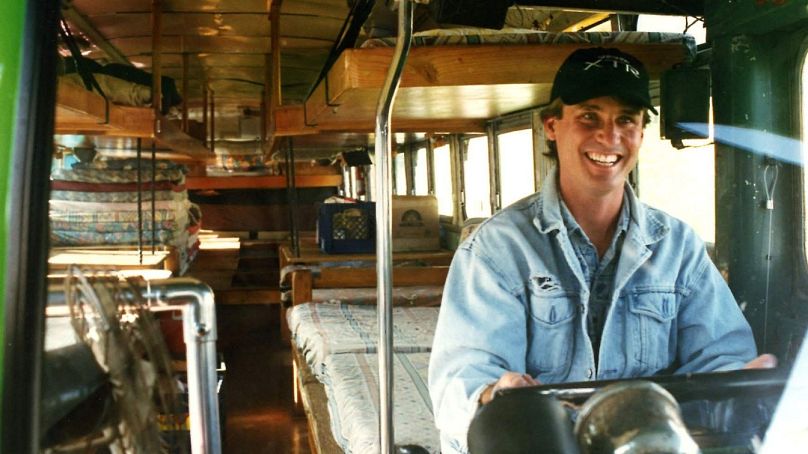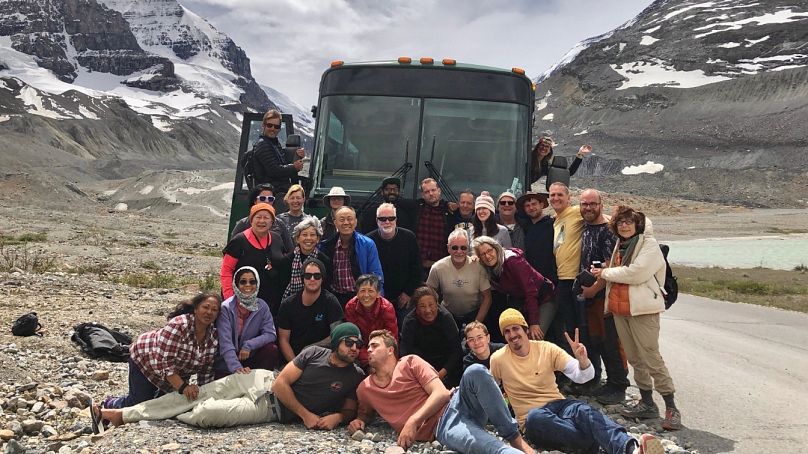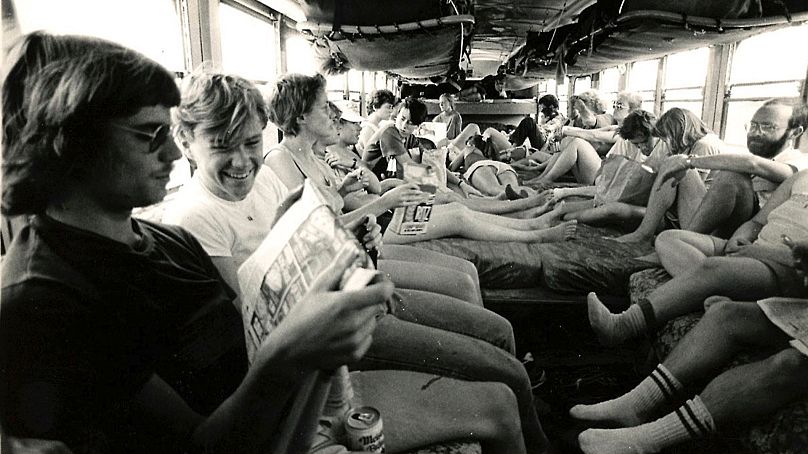American flight-free adventures: What’s it like to cross the States on a bus full of strangers?

Singing songs around the fire on an Indigenous reserve, skinny dipping in hot springs and sleeping beneath a blanket of a million stars, my love affair with slow travel began.
It was 2000, I was 19 and I was meandering my way across the USA on a bus full of backpackers in bunk beds.
This year the aptly named Green Tortoise celebrates 50 years of carrying travellers slowly but sustainably around North America.
Onboard, most of the seats have been replaced by wooden platforms covered in padding to create sleeping spaces. Passengers eat together en route and sometimes sleep out under the night sky.

Travelling the US by bus is all about the journey
Lyle Kent was just six when the Green Tortoise first emerged from its shell. His family was heading home for the holidays from California to New England in the winter of 1973, taking paying customers along for the ride on a converted school bus. He remembers having to get used to sharing his home with strangers.
Nowadays, he runs the San Francisco-based company with partner Amber, having taken over from dad Gardner in 2001.

“We have a unique custom coach carrying individuals from all around the world and of all ages to places both on and off the beaten path,” Lyle says.
“It’s about the journey, about getting out there and doing it. Every trip is different and defined by the people on that trip. They are the ones that make it what it is.”
The trip that ignited my passion for slow travel
Where once up to 40 passengers might have been onboard, nowadays the groups are smaller and enjoy access to aircon and an onboard toilet.
It’s a far cry from my trip from New York to San Fran in 2000, having found out about the Green Tortoise from a few lines in a guidebook.
Looking back, that description from ‘BUNAC’s Moneywise Guide to North America’ seems to capture the very essence of slow travel.
“A kind of alternative bus/tour combo designed to get the budget traveller across country cheaply but in a fun, laid-back way. Time is not of the essence here. The idea is to meander gently with the route changing at the request of the passengers,” it reads.

My letters home tell tales of skinny-dipping, mud-bathing and hiking around a plethora of national parks en route, with an evening in Las Vegas thrown in for contrast.
“Since yesterday, I have been sharing a 1954 converted bus with 38 strangers,” I wrote. “This is our eating, sleeping and travelling space for the next 11 days.
“There are no toilets or showers, but we get to go for a swim every day as we work our way across the country, so at least there are some small blessings. The people are great though and it’s been fantastic fun so far.”
My postcards are a love letter to slow travel, even before I knew what it was.
What’s the slow travel secret to success?
An ability to adapt is what Lyle says has kept Green Tortoise in the race so long.
The company has downsized from its bustling days of running 14 buses on various cross country and West Coast routes in the late 90s and early 00s.
After airfares dropped and chipped away at the budget traveller market, Green Tortoise’s personal touch is what kept drawing travellers back. On one trip last year, two thirds of passengers were repeat guests.

Even in the early days, being adaptable was a must. While the Tortoise first took to the road with old school buses run on petrol, it wasn’t long before the company switched to diesel-powered retired Greyhound coaches. These were designed to cover longer distances and had more luggage space for passengers.
But despite the changes over the years, the company’s core mission remains the same: providing eye-opening adventure travel. Drawing on decades of experience, their itineraries chart hidden secrets, breathtaking scenery and popular tourist spots.
How sustainable is travelling by bus?
If you want to travel more sustainably in 2023, try switching cars and planes for buses and trains.
With US rail infrastructure lagging behind that of Europe, bus travel is a great alternative.
Green Tortoise embraces a sustainable ethos. Its coaches must adhere to California’s strict emissions standards and their custom-built interiors are stripped out and reused when vehicles are upgraded.
Local, seasonal and organic food is bought for communal meals, which are generally vegetarian, and it’s a no to disposable cutlery and plates.
Amber and Lyle also strive to find a balance between visiting big ticket tourist attractions such as Denali in Alaska, while being respectful to the environment, local wildlife and inhabitants.
The experience of group travel also is also rich in lessons of community.
“There are more people in the world, so unless we learn how to all live together, it’s going to be increasingly difficult,” says Lyle. “A week or two on the Green Tortoise makes you realise how important that is, now more than ever.”





